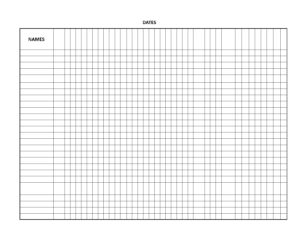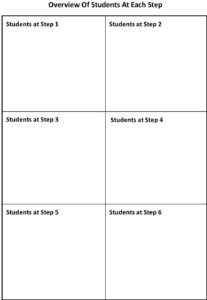Changing The Role Of Teacher
Equal Concern = Equal Time Spent Regularly With Skill Groups
Equal Concern = Equal Consideration of Individual Need &
Time Spent As the Need Arises in a Child’s Work
As Roles Change, the Child’s Need For Teacher’s Time Varies: More During a Step Up, Less at a Plateau
In How Kids Write to Read Approach Was Developed, I described finding that to manage an individualized program, my role needed to be something like that of a doctor who diagnoses, prescribes, and frequently checks for progress — and has nurses and physical therapists (my aides, volunteers, and cross-age tutors) to carry out prescriptions between checkups. In rethinking how to manage my time in this new role — I first had to change my assumptions about giving equal attention to every child during any given day or week. This meant relinquishing the common practice of sorting students into skill-level groups, then meeting with the groups on a regular, rotating basis.
Just as my role changed, the children’s role, too, was very different from that of a child working within a skill group. Instead of receiving lessons on how to do what everyone else in their group was doing, they were now sitting individually with someone older, watching as they used the child’s words to model communication through print. Then immersed — over time — in print with strong meaning for them, the child gradually took over the entire process.
 As they progressed, it was like climbing up steps of increasingly complex literacy skills. It usually took 2 or 3 sessions with me until they made it one step up, where they reached a sort of plateau, remaining there for as long as they needed to hone their new skills.
As they progressed, it was like climbing up steps of increasingly complex literacy skills. It usually took 2 or 3 sessions with me until they made it one step up, where they reached a sort of plateau, remaining there for as long as they needed to hone their new skills.
Once at the new plateau, they may remain at that level for days, weeks, or even months. Then when it looked as if their work was becoming too easy for them, I called them to my table to check. There, if ready to move up, they again spent 2 or 3 sessions with me, as I helped them make it up to the next Step and to its plateau. Again, they worked there for as long as they needed. And so on it went through the 6 Steps.
So as they progressed through the Steps, a child’s need for my time varied: The”Step up” had to be done with my help, but the “plateau phase” could be supported by my helpers just as well as by me. Since I was very careful not to move a child up until I was certain they could manage it, very seldom, if ever, did a child need help from me during their practice/plateau phase. All they needed was someone to model how their speech looked in print, and after that, they were just practicing to perfect their new skills. So although I did check on all students frequently, my job was primarily to watch for signs of students who had accomplished enough that their current Step/plateau was no longer challenging enough for them.
The result of this change in both my role and theirs was that I could devote quality time to individuals as the need arose in their work, and that each child could proceed individually, with skills they actually needed to be working on, and at their own pace.
Three Ways to Assure Equal Consideration
Looking again at the statement at the top of this page, Equal Concern means a teacher needs to give Equal Consideration of Individual Need. But how does a teacher do that — keep track of where everyone is and what they need, when they are all scattered around and often moving about every morning, in a active workshop setting? (Instead of seated in groups were it’s easy to see what everyone is doing.)
 How to provide for equal consideration:
How to provide for equal consideration:
Allow for time after working with individuals each day to get up from the teacher’s table and circulate to see how others were doing.  So I usually only worked with 4 to 6 children individually at or near my round table at the beginning of the Writing Work Period each morning. After that, I would leave my table and move around the room, to see how things were going — looking for who was still finding their work challenging enough and who, instead, might be ready to move on. I might decide to meet with someone the next day and find they were not ready, or I might move them on — I had to see.
So I usually only worked with 4 to 6 children individually at or near my round table at the beginning of the Writing Work Period each morning. After that, I would leave my table and move around the room, to see how things were going — looking for who was still finding their work challenging enough and who, instead, might be ready to move on. I might decide to meet with someone the next day and find they were not ready, or I might move them on — I had to see.
Require each child to bring their work to me by the end of the period, so that I could “see it” once they had finished. And to be sure that everyone did, I pinned a clothespin somewhere on their clothing after making a comment about it. (I stood at the door and collected the clothespins as the children went out to recess. On days when we weren’t ready to end the work period when the recess bell rang, I used a little ritual: I had the class “freeze” in place, leave their work exactly where it was, pause for a moment, then walk slowly out. Then when recess was over, I had them walk carefully back in and resume their work. In that case, I collected pins after I had later called for clean-up.
Requiring each child to ask for a visual signal made all the difference in my confidence that I really could have “remote control” over what the children were accomplishing in my active classroom. And it was crucial that the child was the one responsible for having a pin by the end of the period. Checking everyone’s work was another opportunity to discover who I might call to my table. From what I saw during these times, I began to plan each morning which children to call to me the following morning.
Keep the very simple record keeping forms shown next helped assure I would keep track of how everyone was doing.
Two Record Keeping Forms: One to Assure Equal Consideration of Work and Another to Keep Track Of Each Child’s Progress
 When I began, I kept all this “in my head.” And I did a pretty good job of knowing where each of my students was operating. But eventually I decided that with so much going on in my room, I decided I should have a way to be certain I wasn’t overlooking anyone. So I used a simple printable, PDF version of a blank class Chart, with names on the left and dates at the top, to mark / for which children I planned to call to me the next day — and then changing that to an X, once I actually met with them. With this I could see at a glance whether too much time had gone by since any one child met with me.
When I began, I kept all this “in my head.” And I did a pretty good job of knowing where each of my students was operating. But eventually I decided that with so much going on in my room, I decided I should have a way to be certain I wasn’t overlooking anyone. So I used a simple printable, PDF version of a blank class Chart, with names on the left and dates at the top, to mark / for which children I planned to call to me the next day — and then changing that to an X, once I actually met with them. With this I could see at a glance whether too much time had gone by since any one child met with me.
 To keep track of where each child was in the 6 Steps, I used this printable, PDF version of Overview Of Students At Each Step. I wrote each child’s name under the Step they were currently on, then when they moved forward, crossed off their name and wrote it in the next Step. Sometimes I wrote a very brief note beside their name, but mostly I wrote usually just an abbreviation of what they still needed to master before they would be ready to move forward. Every couple of months, with several names crossed off and written again in the next Step, along with several old notes, this chart became very messy. So I transferred their names to a new one and started over again.
To keep track of where each child was in the 6 Steps, I used this printable, PDF version of Overview Of Students At Each Step. I wrote each child’s name under the Step they were currently on, then when they moved forward, crossed off their name and wrote it in the next Step. Sometimes I wrote a very brief note beside their name, but mostly I wrote usually just an abbreviation of what they still needed to master before they would be ready to move forward. Every couple of months, with several names crossed off and written again in the next Step, along with several old notes, this chart became very messy. So I transferred their names to a new one and started over again.
I never did any individual record keeping — making up one page devoted to each child. Instead, when I needed to report about a child, I used this simple chart to confirm where that child was operating and then pulled the information for what that meant about their skill development from the charts below.
Quick Access To Each Child’s Standing in Skill Development
Another chart, showing the skills and concepts the child is developing at each Step was helpful for discussing a child’s progress with anyone who might ask, perhaps a parent or the principal. When asked, all I needed to do was check to be sure what Step that child was on. Then I could describe what skills they had developed, what they were currently working on — and where they were headed. Here’s a printable, PDF Version of Skills and Concepts at Each of the Steps.
When Is A Child Ready To Move On?
This next chart, was also helpful when discussing a child’s progress with anyone who might ask. With it I was able to explain what criteria I was using to decide whether a child was ready to move on. A teacher will come to know this intuitively, but it doesn’t hurt to have it written down for others to see. Here’s a printable, PDF version of indicators of Readiness to Move to Next Step.
> 
More About Literacy Skills and A System of “Remote Control”
In addition to the forms show above, to facilitate the way I used my own time during the Writing Work Period, I devised a variety of routines and procedures that helped me to keep track of what each child was doing. I came to think of these as a system of “remote control” over the entire process. You will find illustrations of this in the several pages beginning with Classrooms: Control, Work Cycles and More. But first, you will find two more pages about curriculum beginning with Incorporating Phonics.
next —> Incorporating Phonics
